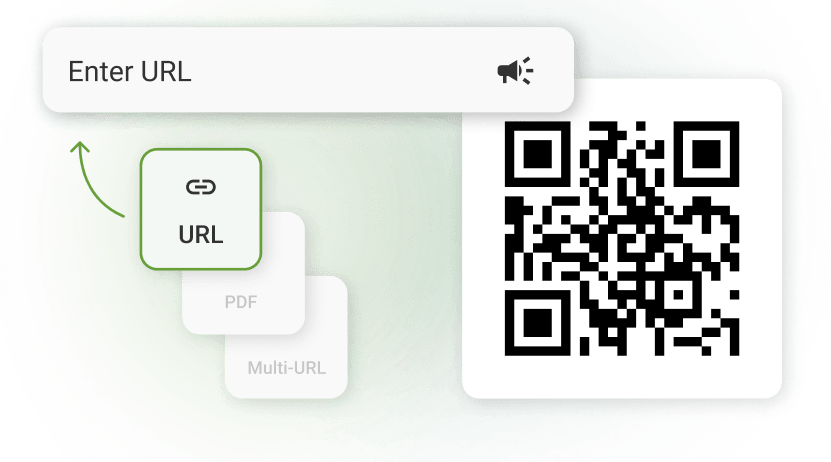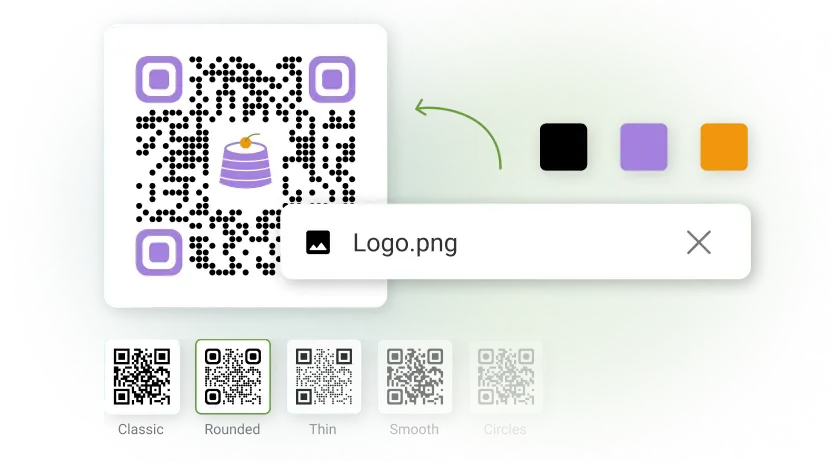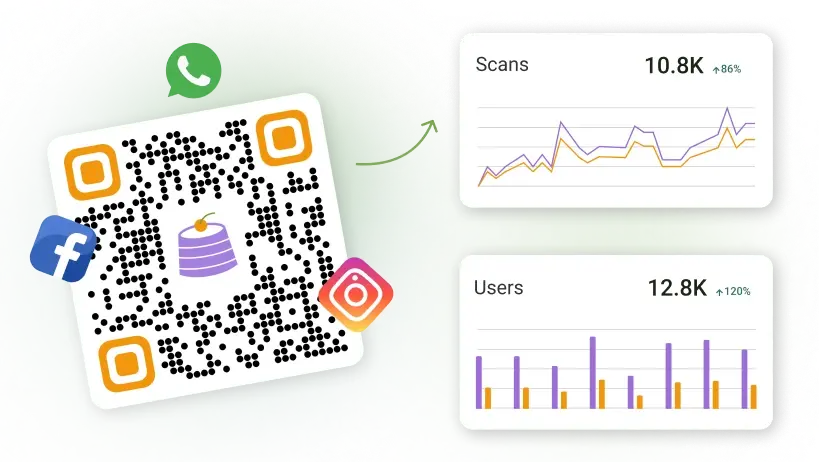Parent participation in school activities has been on the decline for decades. For example, PTA membership nationwide has dropped to 6.6 million from a peak of 12 million, even as student enrollment has grown. This points to a widening gap between parental involvement and school communities.
Traditional newsletters haven’t helped much. A survey shows that more than 70% of parents don’t even read them. Parents are less likely to attend meetings or support school events when communication is missed. This lack of engagement can affect student achievement and the overall school climate.
This is where QR Codes on school newsletters make a real difference. With a simple QR Code scan, parents can instantly access event details, RSVP forms, calendars, or other interactive resources right on their phones. No more digging through paper flyers or typing long URLs.
Table of contents
- How traditional school newsletters without QR Codes limit engagement
- How QR Codes turn passive school newsletters into parent action
- How to build QR Codes on school newsletters
- How do you ensure your school’s QR Codes work flawlessly every time?
- Transform parent communication with a simple scan
- Frequently asked questions
How traditional school newsletters without QR Codes limit engagement
For many schools, the biggest challenge isn’t getting information out but getting parents to act on it. Paper newsletters may deliver announcements, but they rarely inspire meaningful engagement. Instead, they often leave families overwhelmed, disconnected, or unaware of participation opportunities.
Here are four ways parent engagement slips through the cracks when schools rely on traditional newsletters alone:

1. Busy schedules turn good intentions into missed actions
Most parents want to support school events. But between work, after-school activities, and family routines, it’s easy to forget to RSVP or miss a meeting.
Over 70% of parents admit they don’t read paper newsletters, and RSVP slips often get lost in backpacks or sit forgotten on kitchen counters until it’s too late. This “paper-to-action gap” means families who want to participate often never follow through, resulting in chronically low attendance.
2. Static newsletters can’t capture feedback or answer questions
Paper newsletters are a one-way street. They can’t collect real-time feedback or address parent concerns. If an event conflicts with a family’s schedule or requires accommodations, parents have no easy way to respond.
As a result, schools miss critical insights about scheduling conflicts or accessibility needs, which digital solutions can capture instantly through embedded forms and on-time communication.
3. Underattended events drain thousands in lost revenue
Low engagement has a real financial cost. A survey reports a median fundraising amount of $8,500 in 2022–23, with many schools raising only a few thousand dollars.
When families don’t participate, schools lose thousands in potential fundraising revenue. This is money that could have funded programs, supplies, and enrichment activities.
4. Manual follow-ups exhaust teachers and staff
Without digital tools, teachers and staff spend hours each month chasing RSVPs, making phone calls, and updating spreadsheets. This repetitive workload takes time away from teaching and contributes to burnout, which is a leading cause of staff turnover.
Other than missed connections, traditional newsletters drain time, money, and morale. And the costs add up quickly. One UK estimate shows that for a school of just 180 pupils, the annual cost of printing and distributing newsletters can run to about £21.60 per family.
Shifting to QR Code–enabled digital newsletters not only eliminates most of that expense but also solves the engagement problems above.
How QR Codes turn passive school newsletters into parent action

Too often, school newsletters are skimmed (or skipped entirely) because they ask parents to take extra steps later. QR Codes change that dynamic: instead of postponing action, parents can instantly respond, explore details, or share feedback while their interest is fresh.
Here are five smart ways education-related QR Codes transform ordinary newsletters into immediate parent engagement:
1. Pre-filled forms speed RSVPs from days to seconds
Traditional school newsletters often include paper RSVP forms, which can get lost, forgotten, or require follow-up calls and emails from school staff. By placing a QR Code in the newsletter that links to a pre-filled digital form, such as Google Forms or Microsoft Forms, parents can RSVP in seconds.
The newsletter acts as the initial prompt, while the QR Code provides the instant pathway to action. Schools immediately receive responses, reducing manual tracking and reminders, while parents confirm attendance effortlessly.
2. Real-time changes keep information always up-to-date
Event details often change at the last minute. This can be a change in room assignments, weather delay announcements, or schedule adjustments. Traditional school newsletters can’t keep up, and resending updates is time consuming.
Embedding a dynamic QR Code in the newsletter ensures that when parents scan it, they always see the latest information. In this way, the newsletter becomes a live portal, connecting families to up-to-date content without confusion or extra effort.
What is a dynamic QR Code?
A dynamic QR Code lets you change the destination link or content even after printing. One code in the newsletter can later be updated to link to new content (event registrations, permission forms, monthly announcements) without reprinting. It keeps information current while saving time and resources.
Understanding the difference between static and dynamic QR Codes is essential before you use them.

3. Videos and photos create FOMO and boost sign-ups
School newsletters can do more than inform—they can excite and motivate parents. By including a QR Code that links to videos, photo galleries, or event countdowns, newsletters turn passive readers into engaged participants.
Parents see previews of talent shows, book fairs, or performances, creating a sense of FOMO (fear of missing out) that can increase event sign-ups. QR Codes on newsletters motivate more families to get involved by making events feel engaging and unmissable.
4. Private surveys drive higher-quality responses
Paper or email surveys often see low response rates. By embedding a QR Code in the school newsletter that links to an anonymous, secure survey, parents can provide feedback quickly and privately on their phones.
The newsletter delivers the survey invitation directly to families, making it easy for them to respond while the request is fresh in their minds. Surveys delivered via QR Codes can see a 30% increase in participation, giving schools more accurate insights.
5. Tailored outreach reaches every family effectively
Not all families have the same needs or preferences. By including segmented QR Codes in school newsletters, such as different codes by grade, language, or special needs, schools ensure every family receives relevant information.
For example:
- Red QR Code: grades K–2
- Blue QR Code: grades 3–5
- Green QR Code: middle school families
- Spanish-speaking households: link to translated content
- Families of students with special needs: link to accessibility information
The newsletter becomes a targeted communication tool, connecting each family directly to the resources they need.
By embedding QR Codes, school newsletters stop being static papers that sit unread. Instead, they become action hubs where parents can RSVP, check real-time updates, preview events, provide feedback, and access tailored information—all in one place.
How to build QR Codes on school newsletters
Creating QR Codes for school newsletters isn’t just about generating a link; it’s about designing a tool that drives action, improves communication, and makes life easier for both parents and staff. A strategic approach ensures your QR Codes are purposeful, engaging, and measurable.
Below are the steps schools can follow to create a QR Code:
1. Match each QR Code to a clear parent action
The first step is to clarify what you want each QR Code to accomplish. Are you aiming to collect RSVPs for an event, recruit volunteers, gather feedback, or share multimedia resources? Your goal determines the type of QR Code you must create.
For example, a dynamic QR Code is ideal for event updates because you can change content after distribution without printing or resending anything.
The QR Code Generator (TQRCG) is handy here. Schools can combine multiple pieces of content into a single mobile-friendly page using the multi-URL option.

For example, one QR Code for a school play could link to the venue map, registration form, a preview video of rehearsals, and a volunteer sign-up sheet.
Parents get everything they need in one scan, reducing confusion and increasing participation. By aligning each QR Code to a clear goal, schools ensure parents take the intended action rather than leaving the newsletter unread.
2. Design for multitasking and 60-second decisions
Parents are busy and often multitasking, so your QR Code must deliver results quickly. Design every code for the 60-second rule: a parent should be able to scan, view, and respond in under a minute.
Additionally, schools must integrate their branding into QR Code destinations. Use recognizable colored QR Codes, logos, and fonts so parents immediately know the page is authentic. Consistent branding builds trust, increases scan rates, and prevents confusion with external links.
TQRCG allows for easy customization, ensuring that every QR Code feels like an extension of the school’s official communication.

3. Blend physical and digital formats seamlessly
Schools often share newsletters in different formats, such as printed handouts, email blasts, and SMS updates. A smart QR Code strategy ties these touchpoints together.
Place a QR Code in printed newsletters for parents who prefer paper, and share that same QR Code in emails or texts so busy parents can scan it instantly.

With TQRCG’s dynamic QR Codes, you only need one code for both print and digital. Updates happen automatically, so every parent always sees the latest information, no matter how they access it.
4. Use analytics to measure and improve engagement
Administrators should be able to make changes with reasonable insights if a volunteer sign-up QR Code receives far fewer scans than expected. They can adjust placement, tweak messaging, or send reminders.
The QR Code Generator provides detailed scan metrics, including the number of scans, locations, and time of day, which allows schools to measure what works and what doesn’t.

By reviewing metrics regularly, schools can optimize newsletter design, content, and QR Code placement to maximize parent participation and event attendance.
How do you ensure your school’s QR Codes work flawlessly every time?
Even the best QR Code strategy fails if codes are hard to find, links are confusing, or staff aren’t prepared to manage them. Ensuring success requires thoughtful placement, clear content, proper training, and equitable access.
Here are some best practices you should follow to make the best out of your school newsletter QR Codes:
1. Place and style QR Codes for maximum scans
Even the most useful QR Code will not be scanned if parents don’t notice it. In newsletters, placement and design are everything. Place codes near the top of the page or next to key event details so they’re immediately visible.
Add a clear call-to-action like “Scan here to RSVP”, “Get event details”, or “Click to view rehearsals” so parents know exactly why they should scan.
Make sure the QR Code contrasts with the background and is at least 1 × 1 inch for easy scanning on a phone. Avoid placing codes in cluttered areas or at the very edge of the page where they might be overlooked.
For digital school newsletters, consider making the QR Code clickable as well, giving parents multiple ways to engage. Using unique QR Codes for different sections or events also helps track which content drives the most scans, allowing schools to improve future newsletters.
2. Make QR-linked content mobile-friendly and focused
Most parents will scan QR Codes on their phones while quickly glancing at a newsletter. That means your landing pages must load fast, ideally under three seconds, and display correctly on all devices.
Pre-filled forms and simple navigation reduce friction and make it easy for parents to complete the task immediately. Avoid overwhelming them with multiple options in one scan; one main action per QR Code drives the highest engagement and prevents confusion.
3. Train staff and create templates for smooth use
Even a well-designed newsletter QR Code is only effective if staff know how to manage it. Provide teachers and administrative staff with brief guides or training sessions on generating, embedding, and testing QR Codes for school newsletters.
Reusable templates for recurring newsletters or events save time, ensure consistency, and make it simple to drop in the correct QR Code for each issue.
Assign staff to monitor scans and follow up on inquiries captured through the forms, and encourage feedback to refine the process as you learn what works best.
4. Test all QR Codes before publishing
Before sending out a newsletter, always test every QR Code on multiple devices, including iPhones, Android phones, and tablets.
For example, imagine a school sends a QR Code for a spring concert RSVP. If the code works on an iPhone but the registration form doesn’t load properly on an Android device, families using Android phones could miss the chance to sign up.
Testing should also cover real-world conditions: scan the code from a printed newsletter under normal indoor lighting, as well as from a PDF emailed to parents.
A slow or broken link can frustrate parents, leading them to ignore the newsletter and forcing staff to handle unnecessary follow-ups. By testing thoroughly, schools make the experience seamless and reliable, building trust and encouraging participation.
5. Include brief instructions for first-time users
Some parents may not be familiar with QR Codes so a small instruction can make a big difference.
For example, a kindergarten class newsletter includes a QR Code for signing up for parent-teacher conferences. Next to the code, a note reads: “Open your phone camera and point it at the code. Fill out the form to choose your time slot in seconds.”

This simple guidance reassures parents who may be hesitant, especially those less comfortable with technology. In digital newsletters, schools can add a clickable link alongside the QR Code that leads directly to the same form, accommodating parents who may struggle to scan.
Transform parent communication with a simple scan
QR Codes are changing how schools connect with families, turning static newsletters into interactive, measurable, and engaging communication tools.
And you can build these codes with The QR Code Generator. With TQRCG, administrators can build dynamic, multi-purpose pages that combine event RSVPs, volunteer sign-ups, surveys, and multimedia previews in one uninterrupted experience.
TQRCG also provides free access to two dynamic QR Codes forever. This allows schools to experiment with live updates, interactive forms, and targeted communications without any cost. The dashboard’s detailed analytics show exactly which parents engage, when, and how, giving schools the insight to improve future newsletters and events.
The future of school-parent communication is digital, actionable, and data-driven, and it starts with a simple scan.
Sign up and create your free QR Code for newsletters now!
Frequently asked questions
Schools commonly use QR Codes to connect parents to various event-related content. These include:
– Event registration or volunteer sign-up forms
– Updated schedules or calendars
– Student-created promotional videos
– Maps or directions for event venues
– Post-event feedback surveys
By consolidating all this information behind a single QR Code, schools make it easier for parents to access everything they need in one place.
Yes, QR Codes are highly effective because they reduce barriers to participation. Parents can scan a code and access information immediately, eliminating the need to type URLs or search for details manually. For parents who are less familiar with technology, schools often include simple instructions next to the code or provide alternate access options, such as clickable links in digital newsletters or printed URLs in the same issue.
Absolutely. Schools can link QR Codes to multilingual versions of newsletters or event pages, ensuring non-English-speaking families receive the same updates and resources as other parents. This approach helps families feel included, informed, and able to participate fully in school events regardless of language barriers.
Schools track engagement using dynamic QR Codes generated in platforms like The QR Code Generator (TQRCG). Each scan is logged with details such as the number of scans, time of access, and location insights. Schools can also measure completion rates if the QR Code links to a form or survey. By reviewing this data, administrators can see which communications are most effective, which events drive the most participation, and where improvements are needed to boost parent engagement.
Schools can use QR Codes in innovative ways to make events more interactive and fun. For example, QR Codes can be part of scavenger hunts during school events, link to student-made invitation videos, or offer small incentives for completing post-event surveys. These creative approaches not only increase participation but also make events memorable and engaging for both students and parents.







